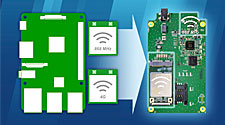Contact · Newsletter · DEUTSCH

Image Caption: The first product version of an IoT solution in the field of sensor data and cloud connections is often derived directly from the proof of concept prototypes. A maker board with a suitable housing then frequently forms the link between the sensor/actuator wireless interfaces and a cloud platform on the internet. Wireless functionality and security have a significant impact on the successful commercialisation of an IoT solution. With the technology components of the eDNP/8331 concept, SSV supports sophisticated solutions for competitive IoT products.
Hanover, February 2024. The first product version of an IoT solution in the field of sensor data and cloud connections is often derived directly from the proof of concept prototypes. A maker board with a suitable housing then frequently forms the link between the local wireless interfaces of the sensors and actuators and a cloud platform on the internet. In terms of time-to-market, this approach is entirely justifiable. However, the ramp-up to a successful market launch often requires cost optimisation in the bill of materials (BoM), functional enhancements for simple deployment and professional cybersecurity. This is why it sometimes makes sense to redesign important technology components at an early stage.
With the eDNP/8331, SSV offers a concept for virtual System-on-Module (vSoM) solutions including various wireless IoT components. This allows circuits of a 32-bit embedded Linux computer to be integrated together with various wireless interfaces into own application circuits in a cost-optimised manner. The results are, for example, sophisticated IoT gateway functions for Wireless-2-LAN (W2L) or Wireless-2-Wireless (W2W) applications with integrated cloud connections based on IEEE 802.15.4, 6LoWPAN, 4G or LEO satellite communication.
The complete hardware and software data of the eDNP/8331 is available as a CAD function block and open source software stack. The CAD data is integrated into the in-house circuit development as part of an Altium PCB design. Once finished assemblies are available, the software stack can be transferred as a binary image to a microSD card or an eMMC memory module and then booted.
As an accessory, SSV offers a template for W2L or W2W vulnerability assessments for analysing the final assembly. This uses a vulnerability scanner to generate a list of critical software components plus the corresponding version numbers. This can then be used to query information on known vulnerabilities in vulnerability databases in order to obtain so-called CVE ID numbers (CVE = Common Vulnerability and Exposure). These CVE IDs can be used to create a risk assessment and prioritisation for own modules in order to initiate appropriate protective measures, such as an AI-based embedded intrusion detection system (IDS).
R&D manager Jürgen Fitschen from SSV explains: "The cybersecurity of the eDNP/8331 is an important milestone to us. In addition to OTA software updates and automatic cyber attack pattern recognition in IoT data streams, we can now also generate a software bill of materials (SBoM) for eDNP/8331 applications. This fulfils one of the main requirements of the EU Cyber Resilience Act."
You will find us at embedded world 2024 in hall 3 // booth 633a (M2M Area).
All information about the embedded world 2024.
Further image material for your reporting
SSV SOFTWARE SYSTEMS
Dünenweg 5
30419 Hannover
Phone: +49(0)511 · 40 000-0
Fax: +49(0)511 · 40 000-40
© 2025 SSV SOFTWARE SYSTEMS GmbH // All rights reserved.
ISO 9001:2015